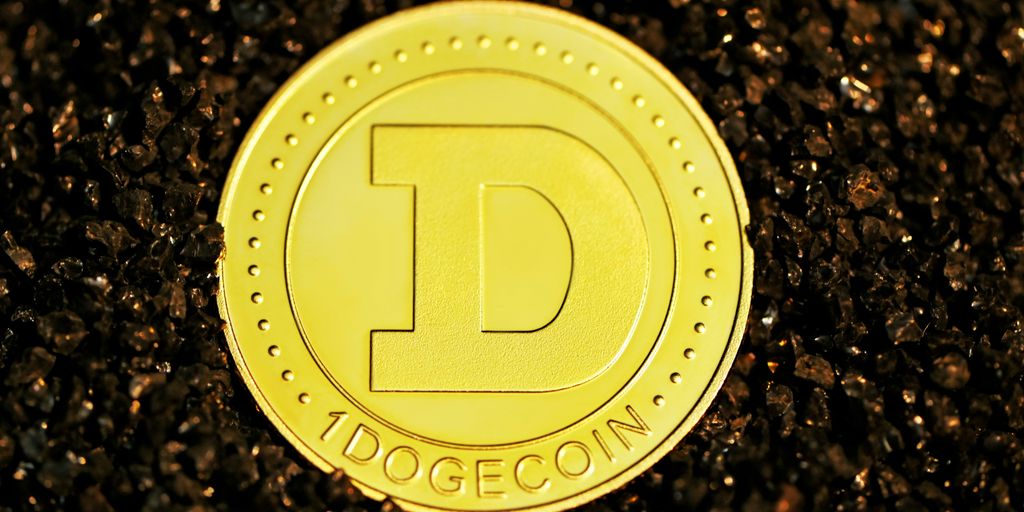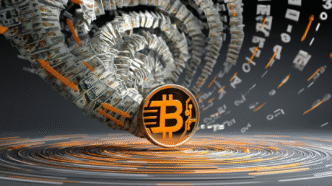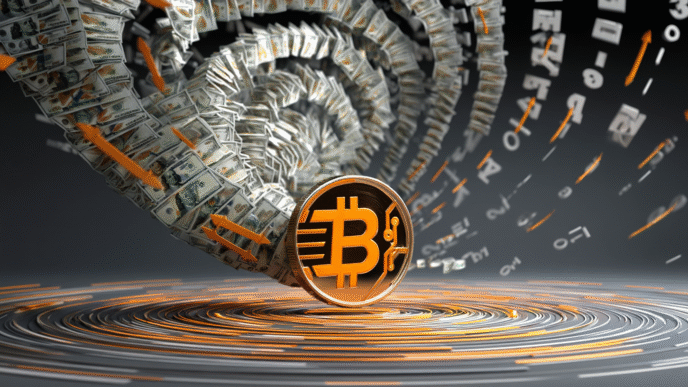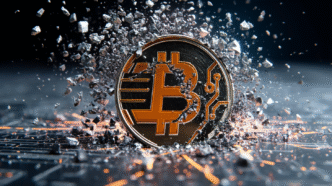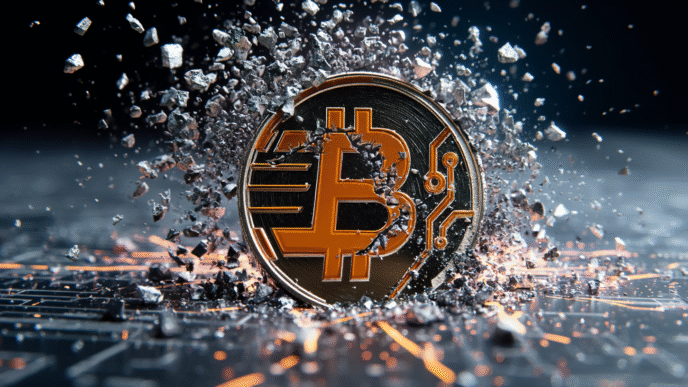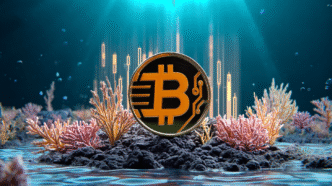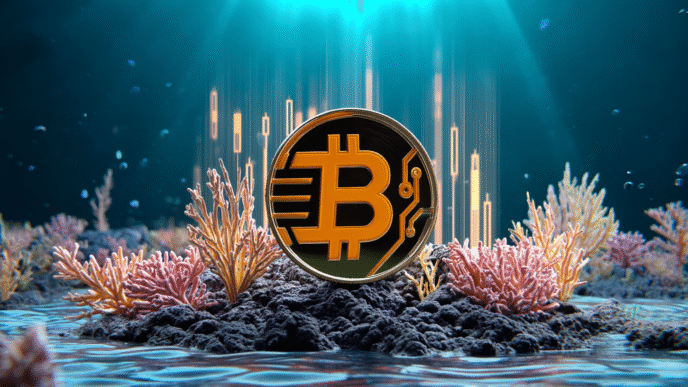So, you’ve heard about DeFi, right? The whole idea of doing finance without banks? It’s pretty cool, but the first version, DeFi 1.0, had some issues. Think clunky interfaces, high fees, and sometimes, money just vanishing due to hacks or bad incentives. Now, we’re seeing something new: DeFi 2.0. It’s like the upgrade everyone was waiting for, trying to fix those old problems and make decentralized finance actually work better for regular people. Let’s break down what that means.
Key Takeaways
- DeFi 2.0 is the next step, aiming to fix the problems found in the first wave of decentralized finance, like high fees and complicated user experiences.
- A big focus for DeFi 2.0 is making liquidity stick around, so projects don’t just attract users for a short time and then lose them.
- Capital efficiency is a major goal, meaning the money in DeFi systems should be used in smarter ways, not just sitting idle.
- Security is being beefed up in DeFi 2.0, with better ways to protect users from hacks and unexpected losses.
- The future of DeFi 2.0 involves bringing real-world assets onto the blockchain and making it easier for big institutions to get involved.
Understanding The Evolution To DeFi 2.0
DeFi, or decentralized finance, really shook things up by letting us do things like lending, borrowing, and trading without needing a bank. It was all built on public blockchains, which was pretty neat. But, as with anything new, the first version, what we now call DeFi 1.0, had its issues. Think about it: sometimes the money people put in would just leave quickly, the rewards offered to get people to join could be way too high and not sustainable, using the apps was clunky, fees were high, and things could break easily if one part of the system had a problem. Plus, there were always security worries.
That’s where DeFi 2.0 comes in. It’s like the next step, trying to fix those problems. The main idea is to make things more stable and last longer, especially when it comes to the money people put into these systems. It’s also about making sure the money we use works harder and that everything is safer and actually useful for everyday people.
DeFi 1.0: Limitations Of The First Wave
DeFi 1.0 was groundbreaking, but it wasn’t perfect. One of the biggest headaches was "mercenary liquidity." This is when people would put their crypto into a platform just to get high rewards for a short time, and then pull it out as soon as better rewards showed up elsewhere. It made it hard for projects to keep a steady amount of money available for trading or lending.
Another issue was the user experience. If you weren’t already deep into crypto, using DeFi 1.0 apps could feel like trying to solve a puzzle. The interfaces were often complicated, and understanding all the risks involved, like "impermanent loss" (when the value of your deposited assets changes compared to just holding them), was tough.
- Unsustainable Incentives: High reward rates often attracted short-term users, not long-term commitment.
- Clunky User Interface (UI): Many platforms were difficult for newcomers to navigate.
- High Transaction Fees and Slow Speeds: Especially on networks like Ethereum, costs could add up quickly, and transactions took time.
- Security Vulnerabilities: Despite blockchain’s inherent security, smart contract bugs and exploits led to significant fund losses.
DeFi 2.0: Addressing Core Shortcomings
DeFi 2.0 is all about fixing those pain points. The big goal is to create what’s called "protocol-owned liquidity." Instead of relying on users to provide funds that might leave, protocols can actually own and manage their own liquidity. This makes things much more stable.
They’re also looking at ways to make capital work smarter. This could mean letting users use their deposited assets in more ways, or making trading more efficient. Security is a major focus too, with better ways to check code and protect against hacks. And, of course, making the whole experience easier for everyone is a top priority.
Key Goals Of The DeFi 2.0 Movement
The DeFi 2.0 movement has a few main objectives:
- Achieving Sticky Liquidity: This means finding ways to keep liquidity within a protocol long-term, often through better incentive structures or by the protocol owning the liquidity itself. This helps ensure that trading and lending can happen smoothly without constant worry about funds disappearing.
- Enhancing Capital Efficiency: The aim here is to make the money locked in DeFi protocols work harder. This could involve allowing users to get more out of their deposited assets or making financial operations more streamlined.
- Strengthening Security Measures: DeFi 2.0 protocols are putting more effort into security, using methods like formal verification (mathematically proving code works as intended) and on-chain insurance to protect users and their funds.
- Improving User Experience: Making DeFi accessible to more people is key. This includes simpler interfaces, easier ways to manage assets (like smart wallets), and potentially even helping users pay for transaction fees.
Core Pillars Of DeFi 2.0 Innovation

DeFi 2.0 is all about making things work better and last longer. The first version of decentralized finance was cool, but it had some real problems. Think of it like a brand new car that looks amazing but breaks down a lot and is super expensive to run. DeFi 2.0 is trying to fix those issues.
Achieving Sticky Liquidity
One of the biggest headaches with DeFi 1.0 was "mercenary liquidity." This is when people would park their crypto in a liquidity pool just long enough to grab some quick rewards, then pull it out. It’s like a tourist who visits a city for a day, takes a bunch of photos, and leaves without really experiencing anything. DeFi 2.0 wants to change that by creating "sticky liquidity." This means finding ways to keep that capital locked in for longer periods, making the whole system more stable. Protocols are doing this through things like "protocol-owned liquidity" (POL), where the protocol itself buys and holds a portion of the liquidity, or by using special token models that reward long-term holders. It’s about building a more committed user base, not just chasing short-term gains.
Enhancing Capital Efficiency
DeFi 1.0 often meant your money was tied up in just one place. If you put your assets into a liquidity pool, they were stuck there. DeFi 2.0 is looking at ways to make your capital work harder. This includes things like "leveraged liquidity providers," where you can use your deposited assets as collateral to borrow more and provide even more liquidity, potentially earning higher rewards. Another idea is "concentrated liquidity," which lets liquidity providers specify the price range where their assets are active, making their capital more effective. The goal is to get more bang for your buck, so your crypto isn’t just sitting idle.
Strengthening Security Measures
Let’s be honest, the first wave of DeFi had some serious security issues. Hacks and exploits were way too common, and people lost a lot of money. DeFi 2.0 is putting a much bigger focus on security from the ground up. This involves things like more thorough code audits, using formal verification to mathematically prove that smart contracts work as intended, and building in safety features like circuit breakers or insurance pools. It’s about making the system more robust and less of a target for bad actors. Think of it as upgrading from a flimsy lock on your door to a high-security vault.
Improving User Experience
If you weren’t already a crypto expert, using DeFi 1.0 platforms could feel like trying to assemble IKEA furniture without instructions. It was complicated, confusing, and often came with high fees and slow transaction times, especially on networks like Ethereum. DeFi 2.0 is trying to make things much more user-friendly. This includes ideas like "account abstraction," which could let you recover your account if you lose your private key, or "gas sponsorship," where a platform might cover your transaction fees. The aim is to make DeFi accessible to more people, not just the tech-savvy elite. It’s about making the experience smoother, so you can focus on what you want to do, not how to do it.
DeFi 1.0 Versus DeFi 2.0: A Comparative Analysis

So, we’ve talked about what DeFi 2.0 is trying to fix, but what does it actually look like when you put the old version next to the new one? It’s not just a few tweaks; it’s a pretty big shift in how things work.
User Experience And Risk Protection Differences
Back in the day, using DeFi 1.0 felt like trying to assemble IKEA furniture without instructions. It was complicated, and if you messed up, you could lose your money pretty easily. Think about trying to lend your crypto or provide liquidity – it was a maze of settings and potential pitfalls. Impermanent loss, where the value of your deposited tokens could drop just because of market swings, was a big worry. DeFi 2.0 is trying to make this way simpler. The goal is to have apps that are easier to use, almost like your regular banking apps, but without the bank. Plus, they’re building in ways to protect you from those nasty impermanent losses and other risks that made early DeFi feel like a gamble.
Cost And Speed Improvements
Remember those gas fees on Ethereum? Sometimes they were so high, it cost more to make a transaction than the transaction itself was worth. And waiting for your transaction to go through? It could take ages, especially when the network was busy. DeFi 2.0 is tackling this head-on. By using newer blockchain tech and different ways of handling transactions, it’s aiming to bring those costs way down and speed things up considerably. This means you can actually use DeFi for smaller amounts and more frequent actions without breaking the bank or waiting around all day.
Liquidity And Governance Advancements
One of the big issues with DeFi 1.0 was "mercenary liquidity." People would provide funds just to grab the high rewards and then leave, which made things unstable. DeFi 2.0 is all about "sticky liquidity." This means creating systems where liquidity providers are more invested in the long term, often through special tokens that lock up their funds for longer periods in exchange for more benefits. Think of it like getting a better interest rate for keeping your money in a savings account for a set time. Governance, or how decisions are made in these protocols, is also changing. Instead of just a few people having a say, DeFi 2.0 is pushing for more community involvement, giving token holders more power to vote on the future direction of the projects they use.
Navigating Challenges In The Transition To DeFi 2.0
Moving from the first version of decentralized finance to what we’re calling DeFi 2.0 isn’t exactly a walk in the park. There are definitely some hurdles to clear, and people are still figuring out the best ways to handle them. It’s like upgrading your phone – you get all these cool new features, but sometimes you have to learn a whole new system, and there’s always that worry about losing your contacts.
Consumer Protection In Decentralized Finance
One of the big things with the old DeFi was that if something went wrong, like a bad trade or a scam, there wasn’t much of a safety net. Unlike traditional banks where you might have deposit insurance, DeFi often left users on their own. DeFi 2.0 is trying to build in more ways to protect people, but it’s a tricky balance. How do you keep things decentralized and still offer some level of protection without creating a central point of failure? It’s a question a lot of projects are wrestling with.
Mitigating Vulnerability To Hackers
We all know blockchain is supposed to be secure, but hackers are always finding new ways to exploit smart contracts or user errors. The early DeFi systems had their share of exploits, leading to significant losses for users. DeFi 2.0 is looking at better security practices, like more thorough code audits and maybe even insurance options, but it’s an ongoing battle. It’s like trying to build a fortress – you patch one hole, and they find another.
Rethinking Collateralization Requirements
In the past, if you wanted to borrow something in DeFi, you often had to put up way more collateral than you were borrowing. This made it hard for a lot of people to get involved. DeFi 2.0 is exploring ways to make this more flexible, perhaps by using different types of collateral or more advanced risk assessments. The goal is to make borrowing more accessible without taking on too much risk for the lenders.
Addressing The Need For Private Key Management
This is a big one. Your private key is basically the master key to your crypto. Lose it, and your funds are gone forever, no ifs, ands, or buts. DeFi 2.0 is looking at solutions like smart contract wallets or social recovery methods. These aim to make it easier to manage your keys, or even recover access if you lose them, without completely centralizing control. It’s a tough problem because you want security, but you also don’t want to be locked out of your own money.
Revolutionary Features Of DeFi 2.0
DeFi 2.0 is really shaking things up, bringing some pretty cool new features that fix a lot of the problems people had with the first version. It’s not just about making things faster or cheaper, though it does that too. It’s more about making the whole system work better and be safer for everyone involved.
Unlocking Greater Value From Staked Assets
Remember how in DeFi 1.0 you could stake your tokens in a liquidity pool and get LP tokens back? Then you could stake those LP tokens again to earn more rewards? Well, DeFi 2.0 takes that idea and runs with it. Now, you can actually use those yield farming LP tokens as collateral to take out loans. This means your staked assets can do more work for you, making your capital work harder and giving you more bang for your buck.
Enhanced Protection Against Financial Losses
Let’s be honest, DeFi 1.0 had some rough patches. There were hacks, smart contract issues, and the dreaded impermanent loss, which could really hurt if the prices of your tokens went sideways. DeFi 2.0 is trying to put a stop to that. It’s introducing insurance options, usually for a small fee, that can protect you if something goes wrong. This includes coverage for smart contract failures or if the liquidity pool itself gets compromised. It’s like having a safety net, making it less scary to put your money into these systems.
Multi-Blockchain Support For Scalability
One of the biggest headaches with DeFi 1.0 was that it was mostly stuck on the Ethereum blockchain. As more people started using it, transactions got slow and really expensive. DeFi 2.0 is changing that by spreading out onto other blockchains. This means more options, better speeds, and lower costs for everyone. It’s like opening up the highway to more traffic, making the whole network run smoother.
Superior User Experience And Accessibility
DeFi 1.0 could be pretty confusing, especially for newcomers. The interfaces were often complicated, and you really needed to know your stuff to use them without making a mistake. DeFi 2.0 is focusing on making things much simpler and easier to use. Think cleaner interfaces, more straightforward processes, and features that help guide you along the way. The goal is to make decentralized finance something that anyone can use, not just the crypto experts.
The Future Landscape Of Decentralized Finance
So, what’s next for decentralized finance? It’s not just about making existing financial services available online without a bank; it’s about building entirely new ways to manage and move money. We’re seeing a shift towards systems that are more practical and can actually be used by everyday people and big companies alike.
Real-World Asset Tokenization
This is a pretty big deal. Think about things like property, company stocks, or even your car. Right now, dealing with these assets can be slow and involve a lot of paperwork. Tokenizing them means creating a digital version on a blockchain. This could make them much easier to buy, sell, or use as collateral. It’s like turning a physical object into a digital token that can be traded more freely.
- Making illiquid assets more liquid: Things like real estate or private company shares are hard to sell quickly. Tokenization can change that.
- Fractional ownership: You might be able to own a small piece of a valuable asset, like a piece of art or a building, which wasn’t really possible before.
- Easier access to credit: Tokenized assets could be used as collateral for loans in a more straightforward way.
Intent-Based Systems And Cross-Chain Settlement
Right now, using different blockchains can be a bit like trying to use different phone networks – sometimes they don’t talk to each other easily. Cross-chain settlement aims to fix this, allowing assets and information to move between blockchains smoothly. Intent-based systems are also gaining traction. Instead of telling a blockchain exactly how to do something (like a specific transaction), you just state what you want to happen (your intent). The system then figures out the best way to make it happen, potentially across different blockchains.
- Simplified transactions: Users won’t need to worry about the technical details of which blockchain to use.
- Increased efficiency: Transactions can be routed in the most cost-effective and fastest way possible.
- Better user experience: It makes using decentralized applications feel more like using regular apps.
Institutional Grade Tools For Mainstream Adoption
For DeFi to really take off with big financial players and everyday users, it needs to feel safe, reliable, and easy to use. This means developing tools that meet the standards of traditional finance. Think about better ways to manage risk, more secure ways to handle private keys, and platforms that are easier to understand and interact with. The goal is to bridge the gap between the innovative world of DeFi and the established financial system, making it accessible and trustworthy for everyone.
Wrapping It Up: The Road Ahead for DeFi
So, we’ve seen how DeFi 2.0 is really trying to fix the problems people ran into with the first version. It’s all about making things more stable, easier to use, and safer for everyone involved. Instead of just chasing quick gains, the focus is shifting to building systems that actually last and provide real value. Whether you’re putting your money in, building new tools, or just watching from the sidelines, the key takeaway is to look for projects that are fair, protect their users, and create something genuinely useful. That’s the heart of what DeFi 2.0 is trying to achieve, and it seems like the most sensible way to get more people comfortable with this new financial world.
Frequently Asked Questions
What’s the main difference between DeFi 1.0 and DeFi 2.0?
Think of DeFi 1.0 as the first attempt at creating a new kind of money system that doesn’t rely on banks. It was cool because anyone could use it, but it had some problems. It was sometimes hard to use, could be slow and expensive, and people could lose money easily if things changed quickly or if someone was sneaky. DeFi 2.0 is like an upgrade that tries to fix these issues, making it easier, safer, and more reliable for everyone.
How does DeFi 2.0 help keep my money safe?
DeFi 2.0 wants to make sure that when you put your crypto into something like a lending pool, your money stays put and doesn’t just disappear because of market swings. It’s about making the system more stable and less risky for people who provide their crypto.
Is DeFi 2.0 easier to use than the older version?
One of the big goals is to make DeFi easier to use, even if you’re new to crypto. This means simpler websites, clearer instructions, and maybe even ways to get help if you make a mistake. It’s about making decentralized finance feel less like a secret club and more like a regular bank, but without the bank.
Will DeFi 2.0 make transactions faster and cheaper?
Yes, DeFi 2.0 is working on making transactions faster and cheaper. The first version of DeFi often got bogged down, especially on networks like Ethereum, leading to long waits and high fees. Newer versions are exploring ways to speed things up and cut costs.
What does it mean to bring ‘real-world assets’ into DeFi 2.0?
DeFi 2.0 is trying to bring real-world things, like property or company shares, onto the blockchain. This could open up new ways to use your crypto and connect the digital money world with the physical world of assets.
Is DeFi 2.0 completely safe from hackers and losses?
While DeFi 2.0 aims to improve security, no system is completely risk-free. It’s designed to be more robust against hacks and offer better protection against certain types of losses, but users should still be cautious and understand the risks involved before putting their money into any DeFi project.


